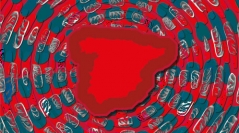

 Geodiversitas
45 (20) - Pages 589-641
Geodiversitas
45 (20) - Pages 589-641The Campisano Ravine in the Ribesalbes-Alcora Basin (Spain, Early Miocene, Biozone C, MN 4) yielded a highly diverse and abundant assemblage of dormice, composed by sixteen taxa belonging to nine different genera, detailed as follows: three species of the genus Microdyromys De Bruijn, 1966 (M. legidensis Daams, 1981, M. koenigswaldi De Bruijn, 1966, and M. aff. monspeliensis Aguilar, 1977), we extend here the stratigraphic range of M. aff. monspeliensis; two taxa of Prodryomys De Bruijn, 1966 (P. aff. satus Mayr, 1979, and P. aff. remmerti Aguilar & Lazzari, 2006), we increase here the known stratigraphic distribution of P. aff. satus and report for the first time P. aff. remmerti in the Iberian Peninsula and biozone MN4; Bransatoglis cf. infralactorensis Baudelot & Collier, 1982, which we found for the first time in the Iberian Peninsula; two species of the genus Peridyromys Stehlin & Schaub, 1951: P. murinus (Pomel, 1853), the most common dormouse in the basin and P. darocensis Daams, 1999, with its youngest known record; Pseudodryomys ibericus De Bruijn, 1966, less abundant here than in other similar sites; three species of the genus Simplomys: S. simplicidens (De Bruijn, 1966), the most abundant representant of this genus in this basin, S. julii (Daams, 1989), more common than expected for the Iberian Peninsula, and the least frequent S. meulenorum García-Paredes, Peláez-Campomanes & Álvarez-Sierra, 2009; Armantomys aragonensis De Bruijn, 1966, scarcer here than in other Iberian basins; two species of the genus Glirudinus: the largest and rarest G. undosus Mayr, 1979, and the smaller, more common but occurring only in the second local area Cb G. modestus (Dehm, 1950); and finally, Myoglis cf. antecedens Mayr, 1979, which is cited for the first time in the basin. Additionally, the palaeoecological significance of this assemblage is discussed.
Gliridae, Iberian Peninsula, MN4, Rodentia, biostratigraphy, palaeocology